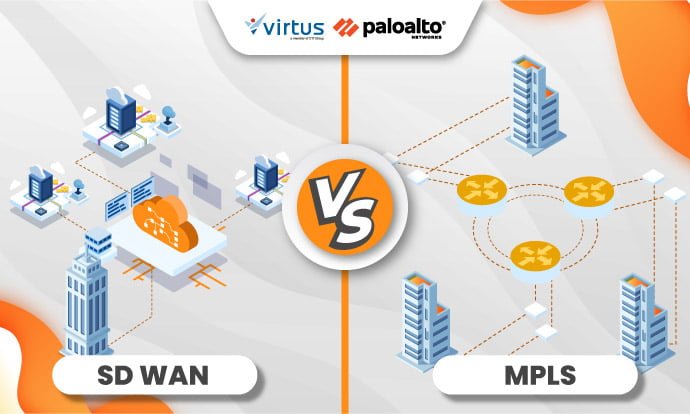SD-WAN is a decentralized and efficient network solution that is rapidly gaining traction in corporate network technology. According to Gartner's 2019 research, SD-WAN is poised to become a mainstream technology with a growth rate of up to 30.8 percent and is expected to displace MPLS technology in corporate network systems.
While MPLS technology still dominates corporate networks, it has some drawbacks, including higher network bandwidth costs. As a result, companies should consider SD-WAN solutions as they offer more benefits than MPLS.
To evaluate which solution is best for your company, it's essential to understand the differences between SD-WAN and MPLS, as well as the advantages and disadvantages of each. Learn more in the article below.
Comparing MPLS vs SD-WAN
MPLS is a hardware-based technique for routing data network traffic. MPLS high-performance networks route data from one network node to the next based on short path labels, avoiding complex lookups in routing tables. Additionally, MPLS can encapsulate packets of various data types, including voice and video communications.
Where SD-WAN is a software-defined wide area network, this solution facilitates an internet connection with a two-point connection, making it more flexible to use with different networks such as wired or wireless.
Calculating the Benefits and Risks of MPLS
MPLS is usually suitable for traditional structured network systems that use WAN connections specifically for data centers, as MPLS provides application access and security inspection. In addition, MPLS also provides a reliable WAN connection equipped with a guaranteed System Level Agreement (SLA) by the operator and Quality of Service (QoS) enforcement that ensures application traffic is prioritized based on this SLA.
MPLS networks that rely on dedicated WAN connections tend to be expensive, as they require a connection to a data center. It can also cause cloud and SaaS application access delays, resulting in poor user service. MPLS networks also utilize separate routers and security devices to optimize connections, which can increase operational costs and complexity.
The Ups and Downs of SD-WAN
SD-WAN works by decentralizing the WAN network, utilizing low-cost broadband with a direct internet connection that allows users to connect to applications hosted in data centers, cloud services, or SaaS. SD-WAN also enables traffic intelligence based on SLA to provide the maximum end-user experience and can enhance application cybersecurity. In addition, SD-WAN also offers centralized management that automates network operations and provides better visibility into network and application performance.
However, while SD-WAN enables digital transformation and cloud adoption, in some cases, require experienced IT staff to migrate traditional architecture networks. The process of configuring this business to have effective and maximize results may have additional costs and complexity.
Which Is Better, SD-WAN or MPLS?
After knowing the advantages and disadvantages of each solution, it can be concluded that SD-WAN provides more advantages than MPLS in terms of end user experience, visibility, and flexibility.
What other advantages does SD-WAN offer compared to MPLS?
Greater Performance Compared to MPLS
SD-WAN provides carrier-independent WAN connectivity, enabling services such as MPLS, broadband, and 5G/LTE to be added to the hub of the network. This provides WAN redundancy and failover by proactively recovering network connections and performance degradations and resulting in an optimal end-user experience for all applications.
Network SLA policies can direct application traffic, thereby enabling direct access to the cloud and SaaS applications, reducing delays, and further increasing performance. In addition, the flexibility to replace MPLS with transport such as broadband and 5G provides more bandwidth availability, which provides a better user experience.
In contrast to SD-WAN, MPLS offers a special link with limited bandwidth to work optimally to access critical personal or business applications hosted in the data center. MPLS also fails to meet traffic requests from distributed SaaS and cloud applications at this time. Lack of bandwidth to provide redundancy, failover, and access to data center backhaul applications leads to poor performance and a degraded user experience.
ROI and Cost of SD-WAN vs MPLS
SD-WAN solutions excel by providing built-in capabilities that include routers, traffic engineering, QoS, cybersecurity, and centralized management. SD-WAN also expands its capabilities in switching, wireless, and 5G delivered on the same device. This integrated solution eliminates many different hardware products and management solutions, thereby reducing costs significantly.
In addition, SD-WAN has visibility capabilities, provides automatic configuration, and Artificial Intelligence for Operations (AIOps) can reduce the time to solve and resolve problems, resulting in a better ROI.
MPLS networks can be very expensive based on the SLA bandwidth, speed, and performance requirements. MPLS WAN links can create points of failure while adding redundant connections to increase availability, which can lead to significantly greater cost and complexity. The centralized architecture system causes delays in accessing cloud and SaaS applications, resulting in a poor user experience.
Overview of SASE and SD-WAN
In addressing SD-WAN migration issues, enterprises are increasingly adopting Secure Access Service Edge (SASE) as a solution that unifies security and networking into one cloud-delivered solution to enable today's hybrid workforce and application needs.
SD-WAN works as a network construct for SASE solutions by providing the means to modernize and consolidate security into a single service by simplifying migration to SASE solutions.
Get Prisma SD-WAN from Palo Alto Network Only on Virtus
It's time to use Palo Alto's Prisma SD-WAN solution to protect your corporate network. Prisma SD-WAN comes with solutions to provide the best security and networking for your company network and is proven to save operational costs by up to 243 percent.
Virtus as the official value-added distributor of Palo Alto, will help your business take advantage of Prisma SD-WAN solutions starting from the consultation, migration, implementation, and maintenance stages. A professional and Virtus-certified IT team will assist with technical issues 24/7. Click here to chat and consult with Virtus team about Prisma SD-WAN.
Writer: William Wong
Content Writer CTI Group



























